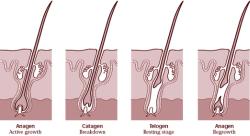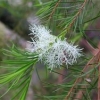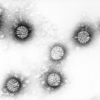Analisi delle variazioni quantitative della crescita dei capelli durante il trattamento con la chemioterapia o tamoxifene nelle pazienti con cancro al seno: uno studio di coorte
 Per quanto l'alopecia indotta dalla chemioterapia (CIA) sia molto temuta dalle donne con cancro al seno, questa rimane un effetto collaterale comune del trattamento antineoplastico. L'esordio, il modello e la quantità di perdita di capelli variano a seconda del regime di terapia e, ancora, non sono stati quantificati con tecniche standardizzate.
Per quanto l'alopecia indotta dalla chemioterapia (CIA) sia molto temuta dalle donne con cancro al seno, questa rimane un effetto collaterale comune del trattamento antineoplastico. L'esordio, il modello e la quantità di perdita di capelli variano a seconda del regime di terapia e, ancora, non sono stati quantificati con tecniche standardizzate.
Obiettivo
Confrontare l'effetto della terapia antineoplastica con chemioterapia o tamoxifene sulla perdita dei capelli, quantificando i parametri tricologici.
Metodi
Sono state incluse nello studio le pazienti con cancro al seno (n=34) sottoposte, dopo intervento chirurgico, a chemioterapia (gruppo C, n=17) o tamoxifene (gruppo T, n=17). Sono stati valutati i parametri tricologici una volta prima della chemioterapia (settimana 0, w0), due volte durante il trattamento (w3, w6) e due volte dopo (w18, w28): normalmente la chemioterapia è durata 16 settimane, così come l'assunzione continuativa di tamoxifene. Ad ogni visita, sono stati quantificati i capelli nella fase anagen e telogen e anche la densità dei capelli attraverso un fototricogramma automatico in due aree definite: quella frontale e quella occipitale.
Risultati
Generalmente, il gruppo T non ha mostrato variazioni del numero dei capelli in anagen e telogen o della densità degli stessi. Nel gruppo C, i capelli in anagen e la densità dei capelli hanno seguito generalmente lo stesso corso: decrescente fino w6, stazionario tra w6-w18 e crescente dopo la cessazione della chemioterapia, fino alla w28 dove hanno raggiunto valori paragonabili, se non addirittura superiori, al basale. I capelli in telogen sono aumentati fino w3 e poi diminuiti fino a w6, rimanendo poi stabili.
Conclusione
La perdita diffusa di capelli inizia poco dopo l'avvio della chemioterapia, principalmente come anagen effluvium con una proporzione di conversione da anagen a telogen. La perdita dei capelli è stata più evidente dopo 6 settimane di chemioterapia; però, entro 3 mesi dalla cessazione della stessa, il tasso di crescita dei capelli è tornato entro i valori basali. Al contrario, il tamoxifene non sembra aver influenzato i parametri di crescita dei capelli.
Storia della pubblicazione:
Titolo: Analysis of quantitative changes in hair growth during treatment with chemotherapy or tamoxifen in breast cancer patients: a cohort study
Rivista: British Journal of Dermatology. doi: 10.1111/bjd.12716
Autori: V. Kanti, R. Nuwayhid, J. Lindner, K. Hillmann, A. Stroux, N. Bangemann, A. Kleine-Tebbe, U. Blume-Peytavi, N. Garcia Bartels
Affiliazioni:Department of Dermatology and Allergy, Clinical Research Center for Hair and Skin Science, Charité — Universitätsmedizin Berlin, Berlin, Germany Department of Gynecology and Obstetrics, Ostalb-Hospital, Aalen, Germany Department of Medical Statistics and Clinical Epidemiology, Charité–Universitätsmedizin Berlin, Berlin, Germany Interdisciplinary Breast Center, Charité — Universitätsmedizin Berlin, Berlin, Germany Breast Center, DRK Clinics Berlin, Berlin, Germany
Abstract:
Background In women with breast cancer, chemotherapy-induced alopecia (CIA) is a highly feared, but common side effect of antineoplastic treatment. Onset, pattern and amount of hair loss differ depending on therapy regime and haven't been quantified using standardized techniques yet. Objective To objectively evaluate and compare the effect of antineoplastic therapy with chemotherapy or tamoxifen on hair loss quantifying trichological parameters. Methods Female breast cancer patients (n=34), receiving chemotherapy (group C, n=17) or tamoxifen (group T, n=17) after surgery were included. Trichological parameters were evaluated once before (week 0, w0), twice during (w3, w6) and twice after (w18, w28) the normally 16 weeks lasting chemotherapy and respectively during the continuous tamoxifen intake. At each visit, anagen, telogen hairs and hair density were quantified by automated phototrichogram in two defined areas: frontal, occipital. Results Group T generally showed no changes in anagen and telogen hairs or hair density. In group C, anagen hairs and hair density generally followed the same course, decreasing until w6, remaining at a low level between w6-w18 and increasing after cessation of chemotherapy, reaching values comparable to or higher than baseline at w28. Telogen hairs increased until w3 and decreased until w6, remaining stable afterwards. Conclusion Diffuse hair loss begins shortly after initiation of chemotherapy mainly as anagen effluvium, with a proportion of anagen to telogen conversion. Hair loss is most prominent after 6 weeks of chemotherapy. Within 3 months after cessation of chemotherapy, hair growth rate returns to baseline values. Tamoxifen didn't affect hair growth parameters.





